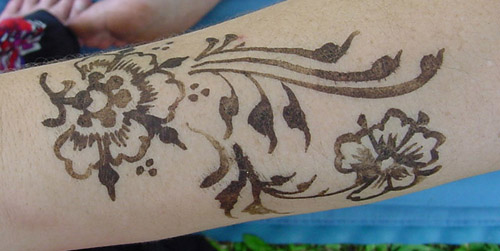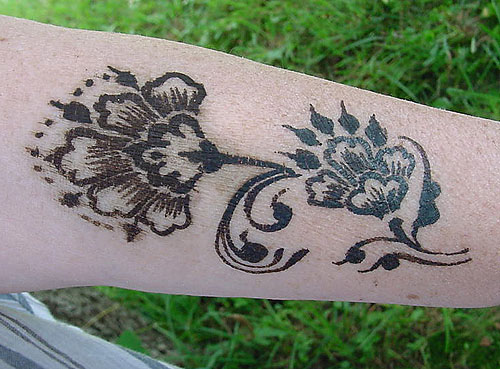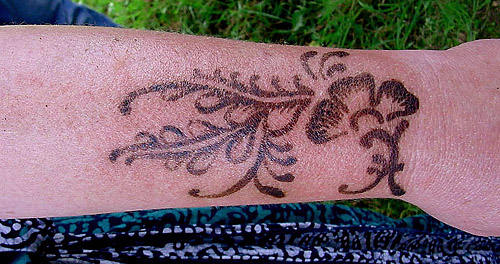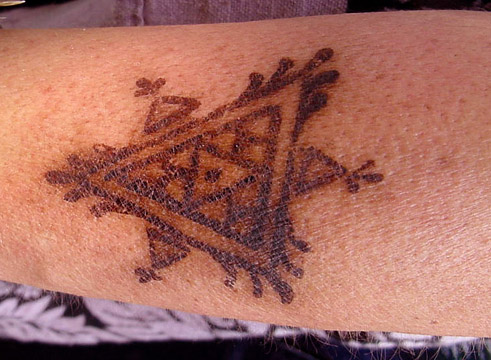|
Khidab
In some countries, traditional cosmetics have very little, if any, standards and regulations for safety. In this period of fast, easy marketing through the internet, cosmetics and items may pass from one country to another and be resold quickly, without inspection of concern for safety. One such cosmetic recently came into my hands. I asked for an ingredient list from the supplier, and none was offered, except for the insistance that this Yemeni cosmetic, "khidab" was ancient, natural, and traditional. Khidab is indeed a traditional cosmetic from Yemen, and there are presently many different ways of making it. Sometimes PPD is included, sometimes its just carbon in a resinous binder. One frequently quoted list of ingredients is: oak gall (used for making ink), copper-oxide and sal ammoniac. All of these are potential skin irritants. If you wish to use khidab, please insist upon a complete list of ingredients, and some evidence of safety testing. Otherwise, you can harm yourself and others. I tested this sample of khidab I recieved on six willing people. I went to a group of people who are my friends and expained that I had a sample of Khidab from Yemen. I explained that I had no knowledge of what was in the sample, but I told them what I had learned from ethnographic material about how khidab is made. One of these people lived most of her life in the Middle East and has been to Yemen several times, and lived among Yemeni neighbors. She recognized the material and recognized the smell. All consented to testing, and understood that I would document the tests, and that I could offer no guarantee of what was in the material, because no information was offered. I told them that I planned to send it to a chemical lab. When prepared as recommended, the results were very pretty.  The picture above is the khidab 18 hours after painting, and after two washings. The supplier recommended that the khidab be painted on, covered and left several hours until the skin sweats a bit. You can see there is some problem with feathering during the sweatting. I had khidab also, and left it on four hours, but did not cover. It washed off my skin completely with soap, and left no stain. There does not appear to be any PPD in this mix, or that would have stained. The khidab was resistant to soap and water when sweatted into the skin.  Above is another picture, showing more feathering during ths sweating.  The image above is of one woman 18 hours after application. Swelling, reddened skin, a very painful burning sensation spread suddenly about 17 hours after application. It began at the site of the application and radiated quickly over the skin, going entirely around the arm. This woman came to me to photograph and document the reaction, then returned to take benedryl to counteract the allergic reaction. Her friend attempted to remove the khidab with olive oil and rubbing alcohol. It was so painful she was screaming and weeping. This is an adult, who is not prone to screaming and weeping. The khidab was completely removed with olive oil and rubbing alcohol. It did not stain the skin. The benedryl reduced the inflamation, though she said the nerves seemed deadened in the area the next day, and there were blisters where the pattern had been.  This is a picture of the other allergic rection. The pattern feathered considerably during the sweating. It is not easy to see the reddened area, but it went clear around the arm, and was intensely painful. You can see that the skin has swollen. This person also removed the khidab quickly after I documented the reaction. The next day, the swelling had subsided, but she also reported loss of sensation in the area, and blistering at the location of the design. Two people had no reaction. I washed mine off early and had no reaction. One other person removed her khidab as soon as she saw her friends allergic reaction, because she wasn't interested in waiting around for pain. I am dismayed that the seller obviously knew that there were allergic reactions to this product, but offered it for sale anyway. I am dismayed that the seller refused to declare ingredients, and has still not declared. I will send the samples to a lab for testing. I am dismayed that my friends were seriously injured because this person did not inform me (or anyone else) of known risks. I am dismayed that the seller trivializes these serious reactions as "some of itch". Those are my tests and documention of the finding. If this person offers you khidab, please be mindful of these tests when you make a decision whether or not to purchase. If anyone else offers you khidab, please be very cautious. Much that is sold as khidab is PPD. This was not PPD, but had something else in it that is a strong sensitizer. According to ethnographic material I have read, many khidab preparations are perfectly safe, but this one clearly IS NOT. It does not stain skin. It is a wash-resistant paint. To identify this ...... it looks like compressed coal, and smells like the lid of an incense burner .... smoky and with a scent of burned myrrh. Can't find what you're looking for? Try: The Henna Page Main Index http://www.hennapage.com/henna/mainindex.html |